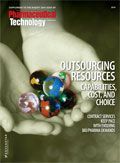Quality by Design in Contract Service Relationships
Contract service providers describe how quality by design has influenced a drug sponsor's expectations of suppliers.

PharmTech: How has quality by design (QbD) influenced a drug sponsor’s expectations of suppliers?
Andrew Strong, president and CEO, VP business development, Kalon Biotherapeutics: Developing a process using well documented, science- and risk-based approach makes sense for CMOs. The process of evaluating the approach to process development and critical process attributes, provides more comprehensive understanding of the process, and mitigates the risk of failure on scale-up. The FDA is requiring more thoughtful, methodology to process development through a QbD process. When operating on a fee-for-services basis, risk mitigation is critical to profitability. The technologies to allow for design of experiment (DOE)-based approaches to process development have allowed form more experimental approaches without increasing timelines or cost.
John S. Ross, executive vice-president, Metrics Contract Services: The International Conference on Harmonisation has embraced QbD, as have the FDA and its European and Japanese counterparts. Despite finding favor with worldwide regulatory authorities, however, QbD still represents for drug sponsors and CDMOs a challenging approach to quality control. For most companies, QbD implementation is not limiting traditional in process or finished product quality testing. More effective and broader implementation industry-wide will require conversation, collaboration, and work.
Richard J. Holl, director, pharmaceutical science, Catalent Pharma Solutions: Because of the recent process validation guidance issued by FDA that establishes the agency’s expectation that QbD be incorporated into drug product and process development throughout the development cycle, we have increased interest by our clients on how to incorporate these practices into their programs. However, the practical application of QbD practices to specific drug product and process development is left to individual sponsors and their providers. The degree of effort required in assessing a particular drug product and/or process is somewhat dependent on the compositional and manufacturing complexity associated with the product.
John Sandles, business analyst, Fujifilm Diosynth Biotechnologies: QbD has been used for years at the company and we generally find it customer-specific whether or not QbD awareness is apparent. Pharma and large biotech tend to expect this as standard, but small/medium biotech may
be less aware of the advantages. We would encourage them to select a CDMO that offers QbD as standard as this will make the process more scalable and commercially attractive.
Wendy Saffell-Clemmer, director, R&D, Baxter BioPharma Solutions: Drug sponsors expect product development organizations to have an understanding of QbD principles and incorporate design of experiment factorial designs into formulation development as well as design space principles in process development. BPS has developed a novel QbD approach to the definition of the primary drying stage of lyophilization, which provides a safe zone of operation bounded by equipment capability and shelf temperature. Benefits of this approach may include faster process development and better process optimization.
Praveen Raheja, associate director, formulations, Dr. Reddy’s CPS: QbD is a concept that has recently been made mandatory by the FDA. The drug sponsor expects QbD to be built into the drug product development or drug process development. CPS has implemented the concept into the development of many of its products. The expectation is that if QbD is built into the process from the beginning it will provide a product that is more robust and reproducible.
Franco Negron, vice-president, N. America operations and integration, Patheon: QbD is now a normal expectation for drug product development, whether you are a drug sponsor or a CMO. Design of experiments is routinely used to understand the product and process characteristics. The challenge is to balance the amount of development work versus the cost and sometimes limited amount of API available. At the same time, there is always pressure to get products to market as quickly as possible.
Paul Skultety, vice-president, pharmaceutical development services, Xcelience: Sponsors are looking to work with people who can put into practice quality-by-design principles in all of their development work. They expect a high level expertise not only scientifically but also in global regulations. More and more clinical studies will be done in the United States and abroad. The work has to be scientifically sound and meet all regulations.

Pharmaceutical Tariffs Are Imminent: How Industry is Bracing for Impact
April 16th 2025On April 14, 2025, the Trump Administration launched a national security-driven investigation into pharmaceuticals, a move that will likely result in tariffs being placed on pharmaceutical drugs, ingredients, and other components that are imported from outside of the United States.